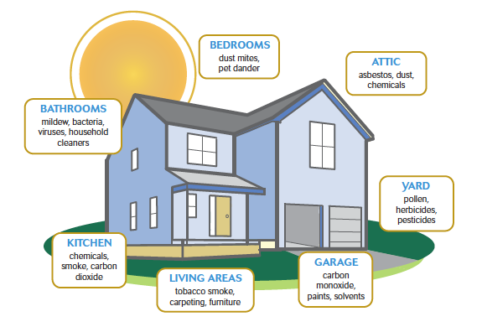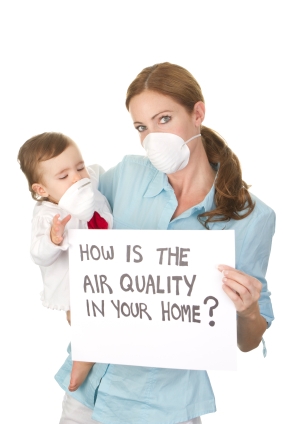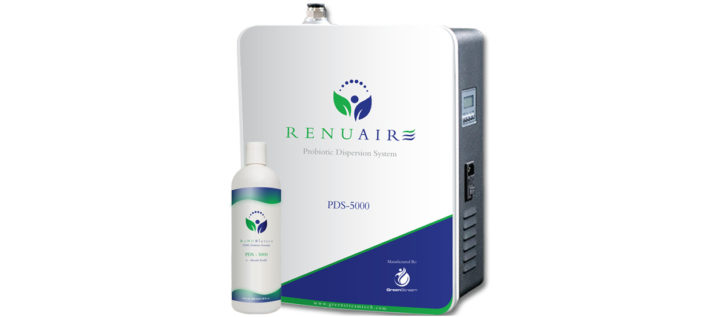It’s the last place you might imagine you’d have to protect yourself. But what you can’t see inside your home could be more dangerous than you think.
For the average homeowner, chances are indoor air pollution is one of the last things on your mind. Most of us think more about pollution as something to keep out of the home rather than something that may already be inside.
Yet there is an entire division of the Environmental Protection Agency solely committed to providing homeowners with information on how air pollutants in your home could be putting you at risk and resources for what you can do about it.
-

-
Types of indoor air pollutants
Here is a list of some of areas for concern, as outlined by the EPA.
- Fuel-burning combustion appliances
- Tobacco products
- Building materials and furnishings like insulation that contains asbestos, newly installed flooring, upholstery or carpet and cabinetry or furniture made of certain pressed wood products
- Products for household cleaning and maintenance, personal care or hobbies
- Excess moisture (that produces mold and mildew buildup)
- Gases like radon and carbon monoxide
- Biological contaminants such as bacteria, molds, mildew, viruses, animal dander and cat saliva, house dust mites, cockroaches and pollen.
The EPA defines indoor pollution sources as materials that release gas or particles into the air. Contributing factors that make matters worse include high levels of moisture and inadequate ventilation.
Effects of indoor air pollution
In general, EPA experts suggest it is most important to consider how much a pollutant emits for how long and how hazardous the emissions are. Building materials, furniture and household products, for example, release pollutants more consistently than intermittent sources like smoking or failure to fix a broken stove or space heater.
In “The Inside Story: A Guide to Indoor Air Quality,” the EPA reports that people spend about 90 percent of their time indoors, where the air “can be more seriously polluted than the outdoor air in even the largest and most industrialized cities.”
A collaboration with the Consumer Product Safety Commission, the guide is incredibly detailed and offers a specific rundown on the potential short and long-term effects of air pollution at home and indoors.
How to improve indoor air quality in your home
Understand indoor air pollution facts
Indoor Air Quality Problem: Pollutants come in a variety of shapes and sizes, but one thing is for sure despite the kind of pollutant: there are a lot of them.
Indoor Air Quality Solution: One of the best things you can do that doesn’t cost you a dime is educate yourself. Understand indoor air pollution facts. There are plenty of things out there that take us by surprise on a daily basis, but the air quality in our home doesn’t have to be one of them.
There are all sorts of precautionary measures we can all take to protect ourselves from the potentially harmful effects of the unseen minions threatening to mess with the quality of the air in our home. Using common sense is one of them. It may be as simple as buying chemical-free paints and cleaning products from now on, but getting educated and starting small can make a difference.
 Use indoor air quality test kits
Use indoor air quality test kits
Indoor Air Quality Problem: According to research done by the EPA, radon is the leading cause of lung cancer among non-smokers and is the second leading cause of lung cancer overall. A national health advisory was issued on radon in 2005, partially due to findings that radon is responsible for about 21,000 lung cancer deaths each year.
Indoor Air Quality Solution: Do-it-yourself radon indoor air quality test kits are relatively inexpensive and can be obtained online or from most home improvement retailers. Indoor air quality testing for radon is incredibly important since it is a colorless, odorless, radioactive gas. The EPA provides resources to help you interpret your results, as well as offer insight on what you can do if you find higher than recommended radon levels for your region.
Make your home smoke free
Indoor Air Quality Problem: The effects of secondhand smoke are nothing new, yet research continues to emerge on the negative impacts the polluted air can have, especially on children.
Indoor Air Quality Solution: Quit smoking, discourage visitors from doing so in your home. The American Lung Association provides resources for homeowners to learn more about the impact second hand smoke has on the home environment, as well as some tips for how to improve air quality after it’s no longer being generated in the home.
Explore the benefits of solar attic ventilation fans
Indoor Air Quality Problem: Insufficient air circulation
Improving indoor air quality is only one of many reasons why ensuring your home is properly ventilated is a smart move. Air circulation in the home is crucial, not only to helping keep the air clean, but also to be more energy efficient and more comfortable. One of the most important spaces to prioritize to maximize the overall efficiency and functionality of your home is your attic.
- In the heat of summer, proper attic ventilation helps keep the space cool, resulting in lower electric bills.
- Research shows roof ventilation products help significantly reduce attic temperatures.
- The year-round benefits of proper roof ventilation systems abound, including helping to protect the structure and materials of your home, aid in reducing energy costs and ultimately make your home a more comfortable place to live.
- In the winter, attic ventilation helps prevent the buildup of condensation on cold surfaces. As a result, you help extend the life of structural components of the roof and prevent growth of mold and mildew.
Indoor Air Quality Solution: Solar attic ventilation
A solar powered attic fan can help facilitate air circulation. Using a combination of progressive solar technology and advanced designs, solar attic fans provide unmatched power and performance. The result is a dynamic product that works to keep your attic cool and dry, ultimately keeping the air in your home cleaner and free of toxic air pollutants.
-
Install a home air purification system
Indoor Air Quality Problem: Some of the biggest offenders causing air pollution in your home are things a lot of us wouldn’t even think about. Building materials and furnishings, newly installed flooring, household cleaning products and biological contaminants like viruses and animal dander fall into this category
Indoor Air Quality Solution: In the case of indoor air pollutants, a fear of the unknown could be costly for your health. Instead, be proactive in your fight against what you can’t necessarily see by installing a home air purification system. Systems like RENUAIRE by Yellowblue offer increased protection from indoor irritants by providing effective and long-lasting residual cleaning of inorganic matter in the air and on surfaces. The natural, chemical-free and environmentally friendly purifier puts environmental probiotics to work to purify the air and hard surfaces through patented technology. Billions of probiotics are intermittently released into the air, consuming organic pollutants like pollens, dust mite waste and pet dander.
Want more tips for improving indoor air quality?
It’s true your home is likely the last place you might imagine having to protect yourself from hazardous conditions. Yet what you can’t see inside your home can pack a powerful punch.
That is why it is especially important to take steps to protect yourself. Start small by getting educated on the kinds of air pollutants that could be a threat. From there, use that knowledge to be proactive and protect yourself by using environmentally friendly products like a solar attic ventilator or probiotic air purifier.
Contact us for more tips for improving indoor air quality. Speak to an independent authorized Yellowblue dealer near you. Your home is where your story begins. Let’s make it a healthy one.
Contact Us

